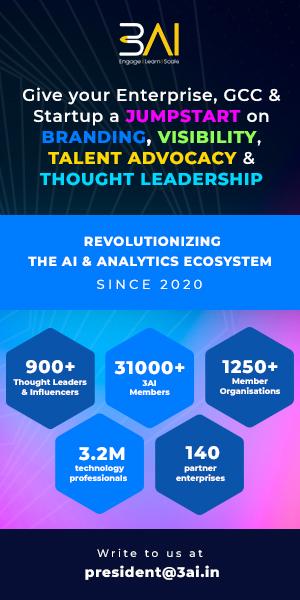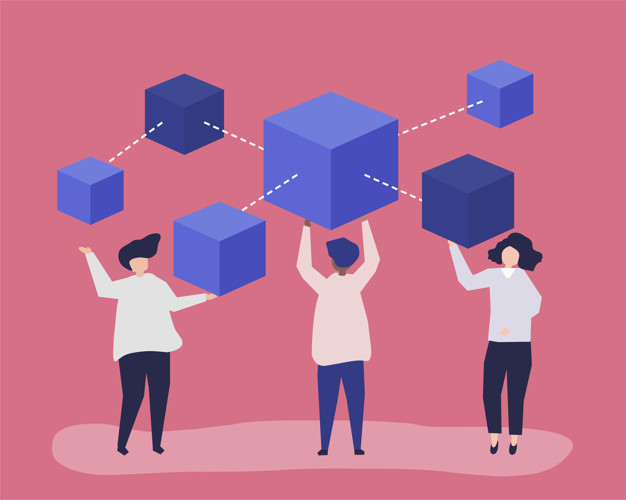How AI can become face of India: A Massive Opportunity
3AI November 26, 2017

This detailed primer will provide you crucial overview of the AI’s increasing prevalence amongst Indian industry, government and peripheral ecosystem and the significant impact AI will have in your organizations to remodel strategic and business models accordingly. The ensuing details also highlights the relative comparison amongst India, China and USA on the steady progress being done in AI adoption.
VC’s, PE funds and investors attempting to understand where to target investment, what offerings and capabilities would lead to better performance and gains, and how to capitalize on AI opportunities, it’s crucial for them to understand the International economic potential of AI for now and projections in the coming years.
Cutting across all these considerations is how to build responsible AI operating models and keep it transparent enough to maintain the confidence of customers and wider stakeholders.
International AI Capitalization Report – China & NA Leads, India hot in the heels
Without doubt, AI is going to be a big game changer in the international setting. A recent PwC report concludes that AI could contribute up to $15.7 trillion to the global economy in 2030, more than the current output of China and India combined. Of this, $6.6 trillion is likely to come from increased productivity and $9.1 trillion is likely to come from consumption-side effects.
Global GDP will be up to 14% higher in 2030 as a result of the accelerating development and take-up of AI
from the standpoint of direct economic impact of AI, China and North America will have greatest gains in GDP. Even though NA will reach its peak of AI led growth faster due to huge opportunities in parallel technologies implementations and advanced customer readiness for AI. NA is supposed to reach the peak of macroeconomic gains by 2020, following which there would be a relative slowdown in the growth.

Figure 1: Souce – PwC Analysis
China, on the other hand will have a slower but stable rise in GDP gains, even post mid 2020s because a large portion of Chinese GDP comes from manufacturing, a sector which is highly susceptible to AI disruption in its operation, and also a higher rate of capital re-investment within Chinese economy compared to EU and NA. As productivity in China eventually catches up with North America, NA will focus more on importing AI-enabled products from China due to economically cheap alternative China provides. Hence by 2030, China will see much larger impact in its GDP.
Sector-wise AI Consumption Impact Index – The sector-wise impact of AI and its constituent offerings space will give crucial overview for investors to get a clear understanding of opportunities and threats in AI investment space. AI is set to be the key source of transformation, disruption and competitive advantage in today’s fast changing economy. Drawing on the findings of our AI Impact Index, we look at how quickly change is coming and where your business can expect the greatest return.

Figure 2: AI Consumption Impact (Src: PwC Analysis)
Deriving from the detailed PwC analysis report, which includes an AI impact index rating which gives an indication of enhancing quality and personalization for consumers and freeing up their time to invest their preferences in other endeavours.
The areas with the biggest potential representation will help your business target investment in the short to medium term. Some aspects could be even more disruptive or even revolutionary, such as robotic doctors, but they would be further off in the timeline of mainstream implementation.
Is the Differential for Developing countries like India too steep in catching up with AI? – AI is still at its early stages, which means that irrespective of the fact that the technology landscape is skewed towards the developed economies as compared to developing, the developing economies and their markets could still lead the developed markets from AI standpoint. This makes countries like India, the second largest economy with a strong focus in IT sector, a strong contender.
The economic impact of AI in GDP for developing countries, will be driven by:
- Productivity gains from businesses automating processes (including use of robots and autonomous vehicles).
- Productivity gains from businesses augmenting their existing labour force with AI technologies (assisted and augmented intelligence).
- Increased consumer demand resulting from the availability of personalised and/or higher-quality AI-enhanced products and services.
The consumer revolution set off by AI opens the way for massive disruption as both established businesses and new entrants drive innovation and develop new business models. A key part of the impact of AI will come from its ability to make the most of parallel developments such as IoT connectivity.
India’s Macroeconomic Landscape of AI
India is already way ahead of many other countries in implementing artificial intelligence (AI). More than half of the companies are going beyond pilot and test projects and adopting the technology at a larger scale. This statistic is largely driven by American firms such as Accenture, Microsoft, the successful implementers’ toolkit, said. Last year, India was the second-largest global site for new centres, after the US.
Well over 58% of the companies that are using AI in India are working with the technology at significant scale
The Indian government’s Digital India initiative, too, has created a favourable regulatory environment for increased use of AI.
Recipe for AI Success in India – Digital & Data Bedrock
As India undergoes rapid digital transformation, data centres and the intelligence behind the data collected will enable the government and industry to make effective decisions based on algorithms. This means increasing opportunities for using (and investing over) AI in the country.
For example, Intel is betting on Artificial Intelligence (AI) to drive demand for its electronic chips, for which it is aiming to train 15,000 scientists, developers, engineers and students on AI in India over the next one year. The company will host 60 courses under its ‘AI Developer Education Program’. These will train people on ways they can adopt AI for better research, testing or even building of products. Intel is looking at India due to the country’s large base of technical talent. The country is the third largest global site for AI companies.
As India’s largest e-commerce marketplace Flipkart closes in on completing a decade in the business, it is looking to put in use its mammoth pile of data to predict sales of products months in advance. The company is working on an artificial intelligence (AI) solution that will give it an edge over rivals by helping it make smarter decisions in ordering, distribution and pricing products on its platform. Ultimately, the AI system will allow Flipkart to boost efficiency and reduce the cost of products for customers.
While rival Amazon, which has around a 10-year headstart over Flipkart, is known to have some of the most advanced sales prediction engines, the Indian company has the advantage of having a bigger data set of the country’s online consumer market.
AI Inroads in the Private Sector
AI has now a significant impact in the day to day lives of the regular mass of the country. Now that the Indian IT sector has reached a certain intermediary peak of digitization, the focus, now , is more on automating the repetitive problems and finding more optimized, efficient or refined methods of performing the same tasks, with less time duration and lesser manpower. The result is the standardization of some very critical app based services like virtual assistants, cab aggregators, shopping recommendations etc. This will eventually lead to AI solutions to real world problems.
The AI Startups Sphere of India- Startups are clearly playing a major role in innovating faster than corporates, which has led to several curious partnerships. SAP India has invested in Niki.ai, a bot that improves the ordering experience. Then there’s Ractrack.AI, where a bot improves customer engagement and provides insights; it functions as a virtual communications assistant to convert the customer into a client. Racetrack is helping companies turn leads into meaningful engagements by using AI. Another startup, LUCEP, converts all potential queries into leads with their AI engine.
The objective is to generate insights from data and simplify customer interaction with a business and also convert them into leads.
Indian startups saw $4 billion in risk capital being deployed across 1,040 angel and VC/PE deals between January and December 2016.
Disclosed funding announcements have shown a decreased value of 55 percent from the same period last year (2015) and a decrease of 20 percent from 2014. About $9 billion in VC/PE capital had been invested in 2015. The number of deals in 2016, however, has increased by 3 percent over the last year. On an average, four startup deals were announced every weekday throughout 2016. VCs predict that going forward machine learning and AI would be key themes to invest in.
AI in Public Sector– Ripe for Digital Revamp and AI Adoption
A Blue Ocean for AI Investment due to Digital India Initiatives – Though both corporates and startups are making significant inroads in instituting AI in their service architecture and product offerings, and sometimes as part of their core business strategy itself, the challenges in the public sector in instituting AI can be quickly overcome due to huge Digital Movements instituted by the Indian Govt. like Digital India, Skill India and Make in India. This will create a solid bedrock of Data and Digital Footprint which will act as a foundational infrastructure to base AI implementation on, opening a huge blue ocean in public sector, rich for AI investment.
A New Workaround for Regulatory Challenges in Public Sector AI Implementation – One of the peculiar problems the public sector faces in mainstream implementation of AI is the fact that since AI is a continuously self-learning system, capable of analytical or creative decision making and autonomous implementation of actions, who will then be accountable in taking responsibility for its actions, should they turn out to be not so favourable. This is because of the fact that since AI has a degree of autonomous decision making, it makes it difficult to pre-meditate its consequence. The AI systems are meant to augment and enrich the life of the consumers. In such a situation, deciding liability of AI system’s actions will be difficult. Therefore, a lot of deliberation will be required to carefully come to a precise conclusion surrounding implementing these systems with ethical foundation and propriety.
Although many countries like US and some European countries are in the verge of implementing regulations and laws surrounding concepts like driverless vehicles, India still don’t have the regulations sanctioned. This, but need not be a bad news. India is cut to establish a completely revamped legal infrastructure, thereby completely circumventing the need for continuous regulatory intervention. Also, there is a favourable atmosphere in India as far as AI is concerned which will foster a spike in activities in that avenue.
Indian Governance Initiatives – Huge Scope for Investment of AI – As India emerges as a premier destination for AI, scope for investment opens in the governance aspect, in several ways. Governance schemes have a unique trait of the baggage of large volume and large scale implementation need, which can be tackled with Deep learning. For example, in Swachh Bharat Initiative, specifically construction of toilets in rural India, public servants are tasked with uploading images of these toilet constructions to a central server for assessment. Image recognition can be used to target unfinished toilets. It can also be used to identify whether the same official appears in multiple images or if photos were uploaded from a different location other than the intended place.
Other initiatives such as the Make in India, Digital India & Skill India can be augmented with AI to deal with scale. The range of application for AI techniques could range from crop insurance schemes, tax fraud detection, and detecting subsidy leakage and defence and security strategy.
An AI system can improve and enrich the agriculture of India by enhancing the bodies like The Department of Agriculture Cooperation and Farmers Welfare, Ministry of Agriculture runs the Kisan Call Centers across the country etc. It can help assist the call centre by linking various available information like soil reports from government agencies and link them to the environmental conditions. It will then provide advice on the optimal crop that can be sown in that land pocket.
As the need for large scale implementation and monitoring of governance initiative becomes more pronounced, the need for AI becomes absolute and it will open doors to considerable AI investment in the future of India.
Finally, Looking Ahead – A Collaborative Innovation Environment due to AI
AI innovations which fall under assisted, augmented and autonomous intelligence will help users understand and decide which level of intelligence is helpful and required in their context, thereby making AI Acceptance easier for the people. At the same time, this AI continuum can be used to understand economic ramifications, usage complexity and decision-making implications. While academia and the private sector conduct research on various AI problems with diverse implications in mind, the public sector with its various digital initiatives (Digital India, Make in India, etc.) can identify areas where parts of the AI continuum can be utilised to increase reach, effectiveness and efficiency, thereby giving direction to AI Innovative Research.
A collaborative innovation environment between academia and the private and public sectors will help provide holistic and proactive advisory delivery to the population, for eg. through public call centres, linking information from various government sources. At the same time, the rich data generated from these interactions can be used to draw deep conclusions. Collaboration between the three pillars could further help get a comprehensive view of problems and find intelligent and innovative ways to increase the efficiency and effectiveness of services delivered to society.





